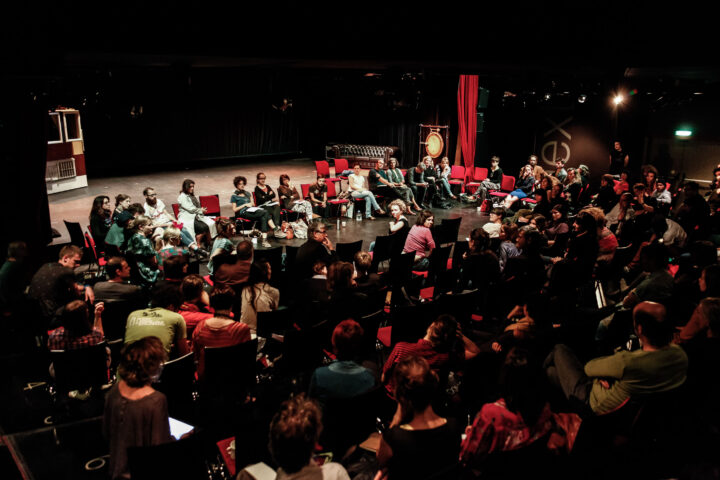Some people are yelling at each other with red faces, others try to stay calm whilst convincing bystanders of the threat of foreigners taking over their country. How Austria stands alone against the rest of the world. An old man almost cries while shaking a newspaper that repeats in large letters the same discussion on its front page. Some Korean tourists watch the strange spectacle without a clue.
15 years ago, when German theatre maker Christoph Schlingensief set up his now legendary container-installation Bitte liebt Österreich! (Please Love Austria!, 2000) right in the centre of Vienna, Chancellor Wolfgang Schüssel had just made his devil’s pact with the right wing demagogue Jörg Haider, and the other EU-countries were discussing sanctions against the fellow member state. Austria debated passionately about immigration policy, as well as about the limits of art. And Europe watched with some bewilderment.
Under the dominating banner ‘Ausländer raus’ (‘Foreigners out!’) Schlingensief staged a Big Brother-type game show with asylum seekers. The containers housed a group of immigrants who could be watched via CCTV on the internet, and the Austrian population was invited to vote them out of the country one by one. The scandal was enormous: conservatives felt insulted by the seeming parody of their argumentation, and the left was disgruntled by the supposedly cynical display.
If political theatre can only exist in a context in which the world is believed to be changeable, in which theatre itself wants to be part of that change, and where there is an audience that is willing to actively engage in the exploration of what that change should be — then it becomes clear why it is so difficult to think of such a theatre today in a society paralysed by the symptoms of post-political ideologies that tend to disguise themselves as positivistic pragmatism, lachrymose resignation, or cheerful complacency. Where the credo of ‘There is no alternative’ (TINA) is considered common sense and the belief in the possibility or even desirability of political imagination is fading, theatre is hit at its core. All its political potential seems disabled.
It was a different time in the 1970s and 1980s when political theatre in Europe actually was (in different ways on either side of the Wall) a relevant factor in many public debates. With ideologies still going strong and the division between east and west clear cut, theatre engaged in everyday politics by representing all the world’s miseries — from the Vietnam War or Apartheid in South Africa to the small daily adversities of a local working class family. Either in new drama or modernised classics, radical interpretations of the text were a key feature of a Regietheater (director’s theatre) which, despite its many new approaches, stayed mostly in the realm of the mimetic. In the east it was a game with hidden messages, in the west open provocations were an important part of the repertoire, and audiences slamming doors while leaving was a rule rather than an exception.
No wonder that large parts of the public still consider this period almost synonymous with ‘political theatre’ itself. But even though the theatre during this period was often able to propose an understanding of the structural reasons behind the presented evils, it couldn’t avoid the dilemma that in the end its representations were just another repetition of the very miseries it wanted to fight. Brecht called this phenomenon ‘Menschenfresserdramatik’ (‘cannibal’s dramatic art’), which he described in the early 1930s in his notes on “Die dialektische Dramatik”: ‘The physical exploitation of the poor is followed by a psychological one’ when the pitied character is supposed to produce feelings of sadness, guilt or even anger in a spectator, who most likely — at least structurally — is part of keeping the very system of exploitation alive. In the end they continued what Brecht had already analysed in his Short Organum for the Theatre (1949): ‘The theatre we know shows the structure of society (represented on the stage) as incapable of being influenced by society (in the auditorium).’ Not only the play onstage but the whole theatrical set up (not to speak of the hierarchies within the institution itself) merely reproduced the system they wanted to criticise.


